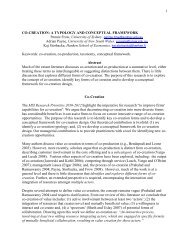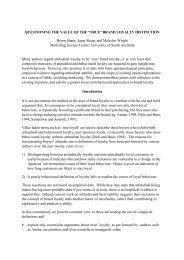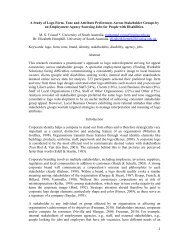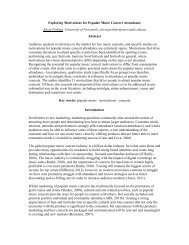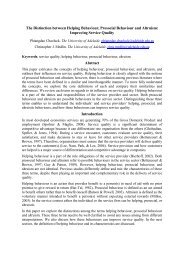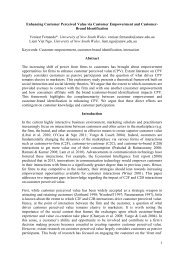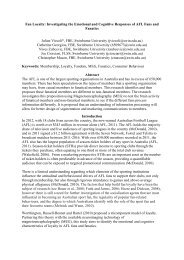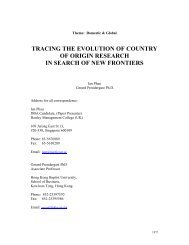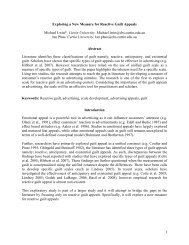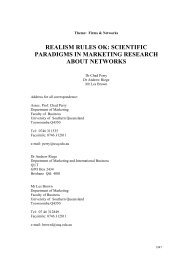UNDERSTANDING CONSUMER INTENTIONS TO ... - ANZMAC
UNDERSTANDING CONSUMER INTENTIONS TO ... - ANZMAC
UNDERSTANDING CONSUMER INTENTIONS TO ... - ANZMAC
Create successful ePaper yourself
Turn your PDF publications into a flip-book with our unique Google optimized e-Paper software.
carpooling with a commuter's life and work, particularly in the commuter/employer relationship.<br />
Company size, assistance in finding carpool partners, worktime flexibility and work schedules<br />
have all been associated with a commuter's propensity to carpool (Cervero and Griesenbeck<br />
1988; Ferguson 1990).<br />
The rideshare literature has been rich and varied in its approach to understanding commuting<br />
behaviour; only a few of the major publications have been discussed here. A major gap in the<br />
carpool literature, however, has been the lack of any systematic approach or underpinning theory<br />
to the research. The wider environmental literature is beginning to develop a theoretical<br />
framework, particularly based on the Theory of Reasoned Action (Fishbein and Ajzen 1975) and<br />
the Theory of Planned Behaviour (Ajzen 1985, 1991). These theoretical approaches are applied<br />
to carpooling in this study in order to better understand the motivations and barriers to<br />
carpooling behaviour.<br />
Applying Marketing Theory to Carpool Behaviour<br />
The Theory of Reasoned Action (TRA) is a theory of attitude-behaviour relationships which<br />
links attitudes, subjective norms, behavioural intentions and behaviour in a fixed causal sequence<br />
(Sparks and Shepperd 1992). Behaviour is asserted to result from behavioural intention, which<br />
in turn is asserted to arise out of a combination of people's attitudes towards performing the<br />
behaviour of interest and their perceptions of the social expectations (norms) put upon them to<br />
perform that behaviour. Attitudes are suggested to arise from a combination of people's beliefs<br />
about behavioural outcomes and their evaluations of those outcomes. Subjective norms are<br />
similarly proposed as arising from a combination of people's perceptions that important others<br />
think they should, or should not, perform the behaviour of interest and their motivation to<br />
comply with the wishes of others (See Figure 1).<br />
Behavioural Beliefs &<br />
Outcome Evaluations<br />
Attitude<br />
Behavioural<br />
Intention<br />
Behaviour<br />
Normative Beliefs &<br />
Motivation to Comply<br />
Subjective<br />
Norms<br />
Figure 1: Model of the Theory of Reasoned Action<br />
The TRA is an appropriate model when behaviour is under an individual's volitional control (i.e.,<br />
if the individual can decide at will to perform or not perform the behaviour). However, the<br />
theory fails to take account of factors that facilitate or inhibit performance of behaviours over<br />
which people have only partial control. The Theory of Planned Behaviour (TPB) extends the<br />
TRA by adding perceived behavioural control as a determinant of behaviour and behavioural<br />
intention, by incorporating a construct that deals with people's perception of control over the<br />
behaviour. That is, their beliefs that they can perform the behaviour if they so desire, that they




